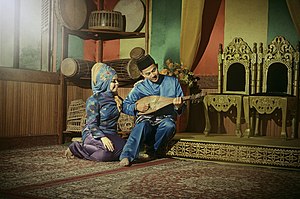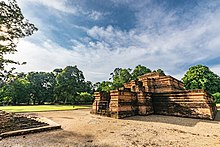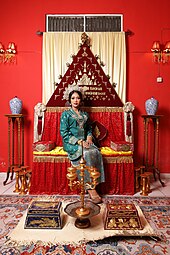Malay Indonesians
Orang Melayu Indonesia ملايو ايندونيسيا | |
|---|---|
 A Riau Malay couple enjoying the traditional Gambus. The background panel incorporated the palettes of Malay tricolour.
| |
| Total population | |
| 8,753,791 (2010) | |
| Regions with significant populations | |
| South Sumatra | 3,139,000 |
| Riau | 2,880,240 |
| West Kalimantan | 1,259,890 |
| Bangka Belitung | 936,000 |
| Jambi | 914,660 |
| Riau Islands | 600,108 |
| North Sumatra | 582,100 |
| Lampung | 269,240 |
| Jakarta | 165,039 |
| Bengkulu | 125,120 |
| Central Kalimantan | 87,222 |
| Languages | |
|
Native Malay (Numerous vernacular Malay varieties) Also Indonesian | |
| Religion | |
|
Predominantly Sunni Islam (98.77%) Minorities • Christians (Protestant and Roman Catholic) (0.98%) • Vajrayana Buddhist • Confucianism • Hindu • Other (0.25%) | |
| Related ethnic groups | |
Malay Indonesians (Malay/Indonesian: Orang Melayu Indonesia; Jawi: اورڠ ملايو ايندونيسيا) are ethnic Malays living throughout Indonesia. They are one of the indigenous peoples of the country. Indonesian, the national language of Indonesia, is a standardized form of Riau Malay. There were numerous kingdoms associated with the Indonesian Malays along with other ethnicities in what is now Indonesia, mainly on the islands of Borneo and Sumatra. These included Srivijaya, the Melayu Kingdom, Dharmasraya, the Sultanate of Deli, the Sultanate of Siak Sri Indrapura, the Riau-Lingga Sultanate, the Sultanate of Bulungan, Pontianak Sultanate, and the Sultanate of Sambas. The 2010 census states that there are 8 million Malays in Indonesia; this number comes from the classification of Malays in East Sumatra and the coast of Kalimantan which is recognized by the Indonesian government. This classification is different from the Malaysia and Singapore census which includes all ethnic Muslims from the Indonesian archipelago (inc. Acehnese, Banjarese, Bugis, Mandailing, Minangkabau and Javanese) as Malays.
History

Sumatra
There are various kingdoms and sultanates related to the history of the Malay people and other ethnicities on the island of Sumatra, such as Melayu Kingdom, Srivijaya, Dharmasraya, Sultanate of Deli, Sultanate of Siak Sri Indrapura, Asahan Sultanate, Riau-Lingga Sultanate, Riau Sultanate, Palembang Sultanate and the Lingga Sultanate, etc.
Kalimantan
There are various kingdoms and sultanates related to the history of the Malay people and other ethnicities on the island of Kalimantan (a.k.a. Borneo), such as Sanggau Kingdom, Pontianak Sultanate, Bulungan Sultanate, Berau Sultanate, Gunung Tabur Sultanate, Sambaliung Sultanate, Paser Sultanate, Kutai Sultanate, etc.
In the Pontianak incidents during the Japanese occupation of the Dutch East Indies, the Japanese massacred most of the Malay elite and beheaded all of the Malay Sultans in Kalimantan.
During the Fall of Suharto, there was a resurgence in Malay nationalism and identity in Kalimantan and ethnic Malays and Dayaks in Sambas massacred Madurese during the Sambas riots.
Languages

Sumatra is the homeland of the Malay languages, which today spans all corners of Southeast Asia. The Indonesian language, which is the country's official language and lingua franca, was based on Riau Malay. The Malay language has a long history, which has a literary record as far back as the 7th century AD. A famous early Malay inscription, the Kedukan Bukit Inscription, was discovered by the Dutchman M. Batenburg on 29 November 1920, at Kedukan Bukit, South Sumatra, on the banks of the Tatang river, a tributary of the Musi River. It is a small stone of 45 by 80 cm. It is written in Old Malay, a possible ancestor of today's Malay language and its variants. Most Malay languages and dialects spoken in Indonesia are mutually unintelligible with Standard Indonesian. The most widely spoken are Palembang Malay (3.2 million), Jambi Malay (1 million), Bengkulu Malay (1.6 million) and Banjarese (4 million) (although not considered to be a dialect of Malay by its speakers; its minor dialect is typically called Bukit Malay). Besides the proper Malay languages, there are several languages closely related to Malay such as Minangkabau, Kerinci, Kubu and others. These languages are closely related to Malay, but their speakers do not consider their languages to be Malay. There are many Malay-based creoles spoken in the country especially in eastern Indonesia due to contacts from the western part of Indonesia and during colonial rule where Malay replaced Dutch as a lingua franca. The most well-known Malay creoles in Indonesia are Ambonese Malay, Betawi, Manado Malay and Papuan Malay.
Sub-ethnic groups of Indonesian Malays
Malay ethnic groups in Indonesia

The Malay people in Indonesia fall into various sub-ethnicities with each having its own distinct linguistic variety, history, clothing, traditions, and a sense of common identity. According to Ananta et al. 2015, Malay Indonesians include:
Sumatra
- Langkat Malays
- Asahan Malays
-
Riau Malays
- Kampar Malays
- Rempang Malays
- Jambi Malays
- Banyuasin Malays
- Lahat Malays
- Lematang people
- Kikim people
-
Pasemah people
- Gumai people
- Kisam people
- Serawai people
- Semendo people
- Semidang people
- Lintang people
- Bengkulu Malays
Kalimantan
- Kayong Malays
- Kotawaringin Malays
- Kutai Malays
- Pontianak Malays
- Sambas Malays
Bali
Sulawesi
- Tawaeli Malays
Aboriginal Malays
- Akit
- Anak Rawa
- Batin
- Bonai
- Lom
- Orang Darat
- Orang Laut
- Orang Rimba
- Petalangan
- Talang Mamak
- Sekak

Notable Malay Indonesians
Literature
- Andrea Hirata, Indonesian author
- Raja Ali Haji, a 19th-century historian, member of the royal house of Riau-Lingga and Selangor and National Hero of Indonesia
Royalty

- Tuanku Sultan Otteman II – a former Sultan of Deli, in which the kingdom's capital was Medan, in North Sumatra.
- Sultan Ma'mun Al Rashid Perkasa Alamyah – 9th Sultan of Deli Sultanate
- Sultan Hamid II – former Sultan of the Pontianak Sultanate
- Pangeran Ratu Winata Kusuma of Sambas – heir to the Sultanate of Sambas
- Sultan Syarif Kasim II – 12th Sultan of Siak Sultanate
Politics
- Marzuki Alie – speaker of the People's Representative Council, 2009–2014 term
- Hatta Rajasa – the Coordinating Minister for Economic Affairs in the Second United Indonesia Cabinet. Previously, he was the State Secretary, Minister of Transport and Minister for Research and Technology in the Mutual Assistance Cabinet (2001–2004).
- D. N. Aidit - the former General Secretary of Communist Party of Indonesia
- Tito Karnavian - the Minister of Minister of Home Affairs. Previously, he was the chief of Indonesian National Police from 2016 to 2019, and chief of the National Counter Terrorism Agency in 2016
- Amir Hamzah – an Indonesian poet and National Hero of Indonesia.
- Hamzah Haz – an Indonesian politician. He is the head of the United Development Party (PPP) and served as the ninth Vice-president from 2001 until 2004.
- Yusril Ihza Mahendra – former chairman of the Crescent Star Party
- Alex Noerdin – the 15th Governor of South Sumatra
- Muhammad Lukman Edy – the former Minister for Acceleration of Disadvantaged Regions in 2007/2009
- Muhammad Sani – the 2nd Governor of Riau Island
- Rizal Nurdin – the 15th Governor of North Sumatra
- Rusli Zainal – the 13th Governor of Riau
- Tantowi Yahya – Indonesian TV presenter turned politician.
Entertainment
- Ariel Peterpan – the lead singer vocalist of Indonesian band Noah
- Carissa Putri – Indonesian model and actress
- Revalina Sayuthi Temat – Indonesian actress, popularly known for her work in Bawang Merah Bawang Putih
- Titi Kamal – prominent Indonesian actress and singer
- Farah Quinn – celebrity chef
- Iyeth Bustami – Indonesian dangdut singer